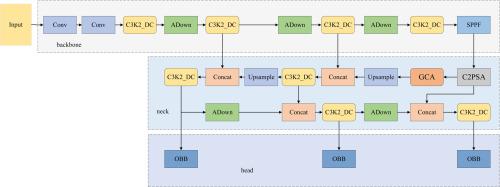An efficient and lightweight rotating target detection model for industrial scenarios
IF 3
3区 工程技术
Q2 ENGINEERING, ELECTRICAL & ELECTRONIC
引用次数: 0
Abstract
Currently, target detection technology has largely matured in industrial scenarios, but most applications still rely on horizontal bounding boxes for target detection. For industrial parts with irregular shapes, varying sizes, and diverse categories, horizontal bounding box detection tends to introduce unnecessary background information, leading to false positives or missed detections. It also suffers from the issue of losing boundary direction. To address these challenges, this paper proposes a novel YOLO11 model for detecting rotating targets (DAGP-YOLO). First, a rotating detection head is introduced to minimize the interference of redundant background information. Dynamic convolution is applied to expand the receptive field of the network, and the ADown module replaces the original down sampling method to improve detail extraction. Second, an orientation-aware attention mechanism (GCA) is designed to better focus on the directional features of rotating targets. Lastly, to meet the demand of small storage space and high detection accuracy of edge devices in industry, this paper adopts the L1 filter pruning strategy to compress the improved model. We performed experimental validation on a self-constructed dataset, the publicly available MVTec Screws dataset, and the UCAS AOD dataset in the aerial photography domain. The results demonstrate the superiority and effectiveness of our approach. Additionally, we developed a visualization system based on the C# WinForms framework, which allows for real-time detection and display of workpiece images, further showcasing the practical applicability of the improved method in industrial settings.

一个高效、轻量级的工业场景旋转目标检测模型
目前,工业场景下的目标检测技术已经基本成熟,但大多数应用仍然依赖水平边界盒进行目标检测。对于形状不规则、尺寸多变、种类繁多的工业零部件,水平边界盒检测容易引入不必要的背景信息,导致误报或漏检。它也有失去边界方向的问题。为了解决这些问题,本文提出了一种新的YOLO11旋转目标检测模型(DAGP-YOLO)。首先,引入旋转检测头,最大限度地减少冗余背景信息的干扰;采用动态卷积扩展网络的接受域,采用down采样模块替代原有的down采样方法,提高细节提取能力。其次,设计了方向感知注意机制(GCA),以更好地关注旋转目标的方向特征。最后,为了满足工业中边缘器件存储空间小、检测精度高的要求,本文采用L1滤波器剪枝策略对改进模型进行压缩。我们在自构建的数据集、公开的MVTec螺钉数据集和航空摄影领域的UCAS AOD数据集上进行了实验验证。结果表明了该方法的优越性和有效性。此外,我们开发了一个基于c# WinForms框架的可视化系统,该系统允许实时检测和显示工件图像,进一步展示了改进方法在工业环境中的实际适用性。
本文章由计算机程序翻译,如有差异,请以英文原文为准。
求助全文
约1分钟内获得全文
求助全文
来源期刊

Digital Signal Processing
工程技术-工程:电子与电气
CiteScore
5.30
自引率
17.20%
发文量
435
审稿时长
66 days
期刊介绍:
Digital Signal Processing: A Review Journal is one of the oldest and most established journals in the field of signal processing yet it aims to be the most innovative. The Journal invites top quality research articles at the frontiers of research in all aspects of signal processing. Our objective is to provide a platform for the publication of ground-breaking research in signal processing with both academic and industrial appeal.
The journal has a special emphasis on statistical signal processing methodology such as Bayesian signal processing, and encourages articles on emerging applications of signal processing such as:
• big data• machine learning• internet of things• information security• systems biology and computational biology,• financial time series analysis,• autonomous vehicles,• quantum computing,• neuromorphic engineering,• human-computer interaction and intelligent user interfaces,• environmental signal processing,• geophysical signal processing including seismic signal processing,• chemioinformatics and bioinformatics,• audio, visual and performance arts,• disaster management and prevention,• renewable energy,
 求助内容:
求助内容: 应助结果提醒方式:
应助结果提醒方式:


